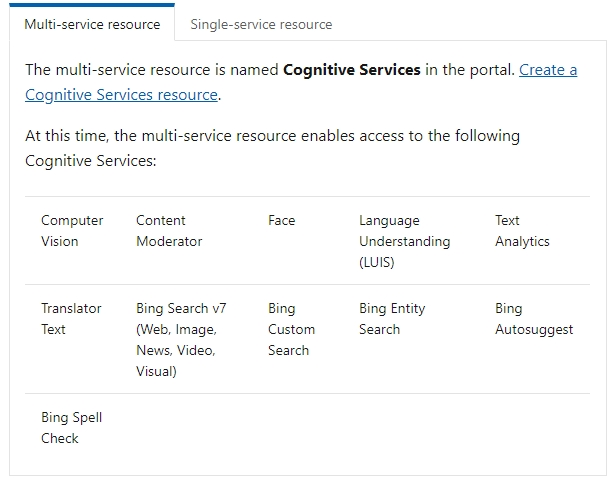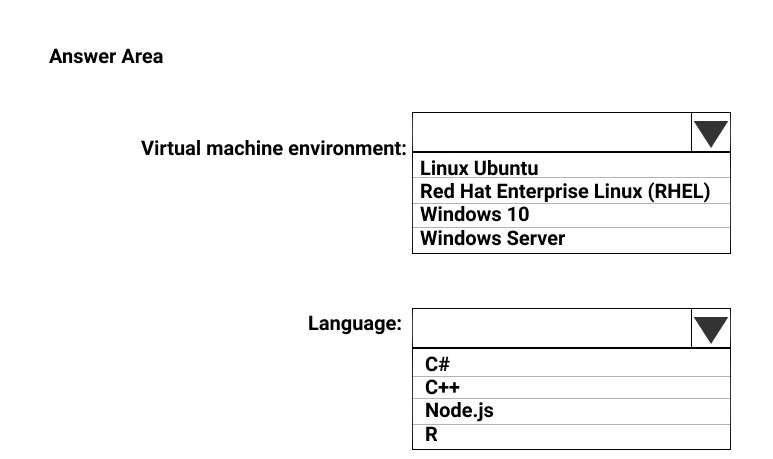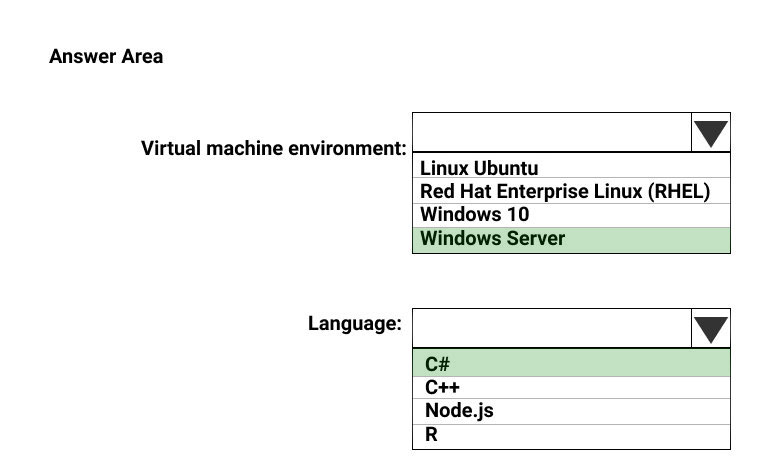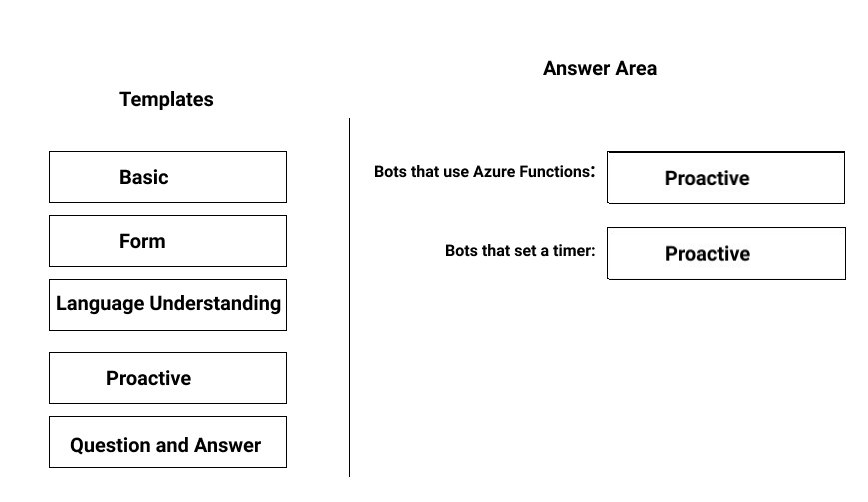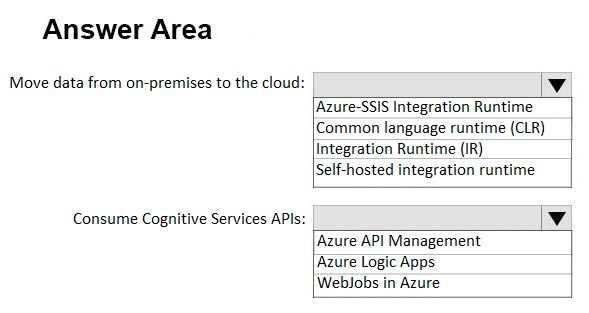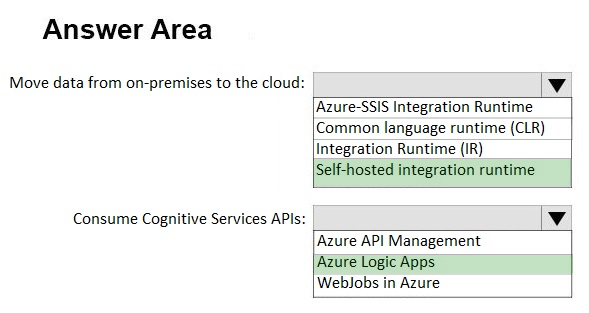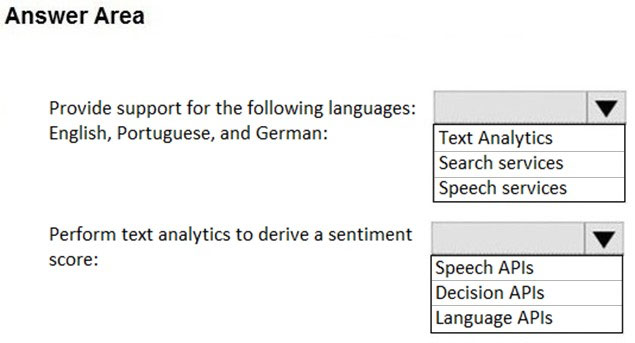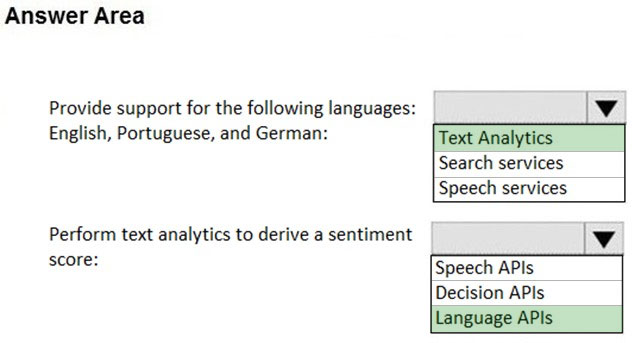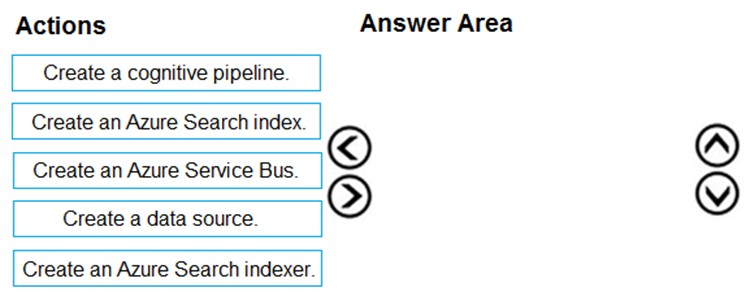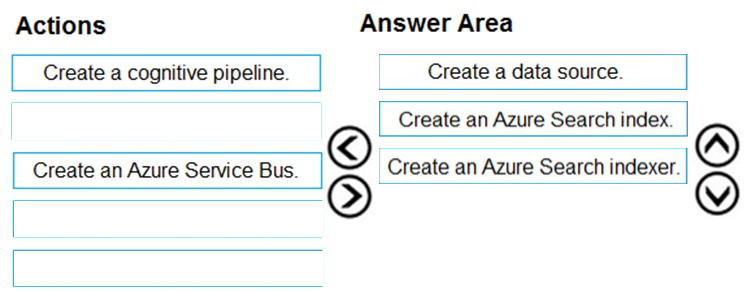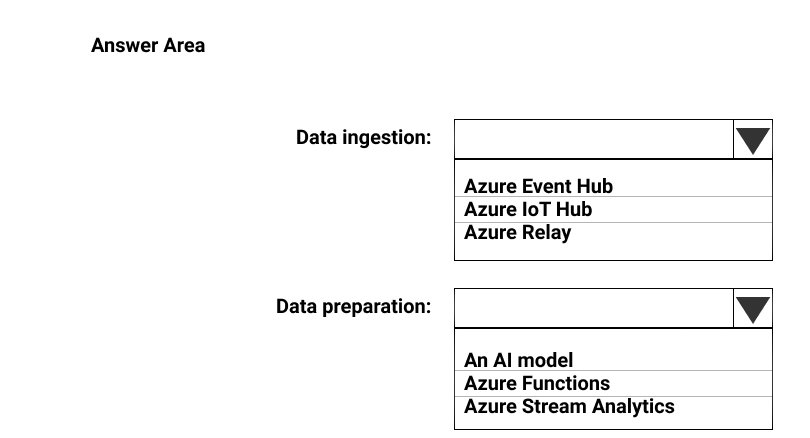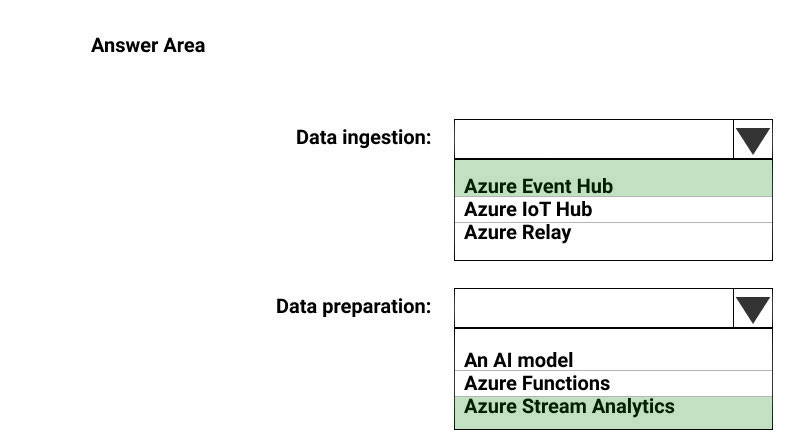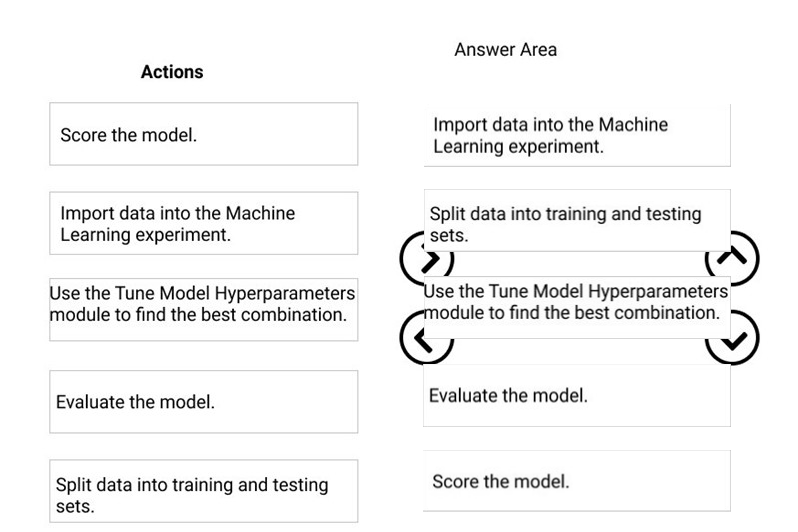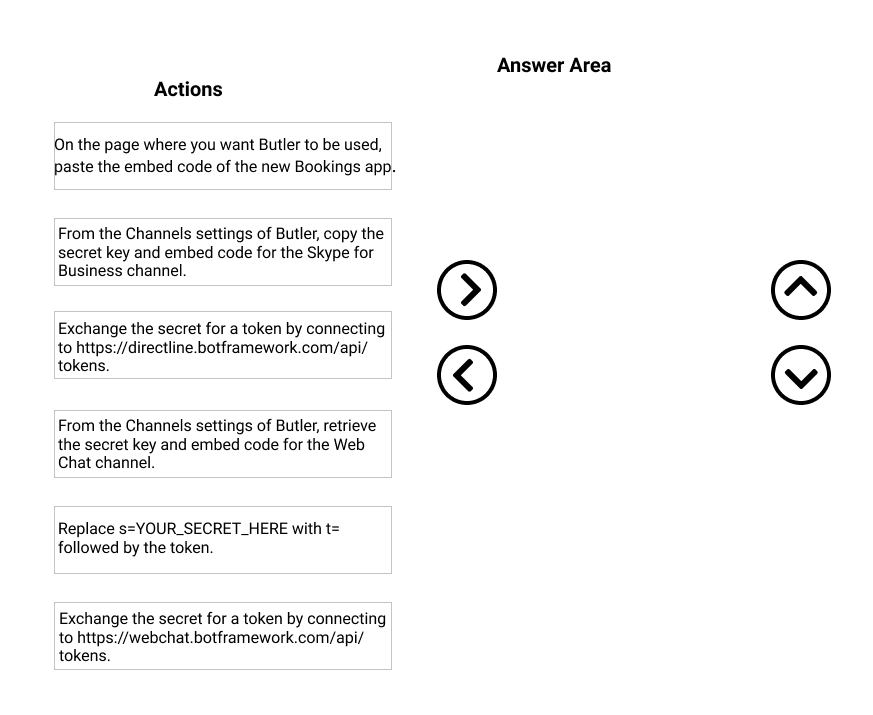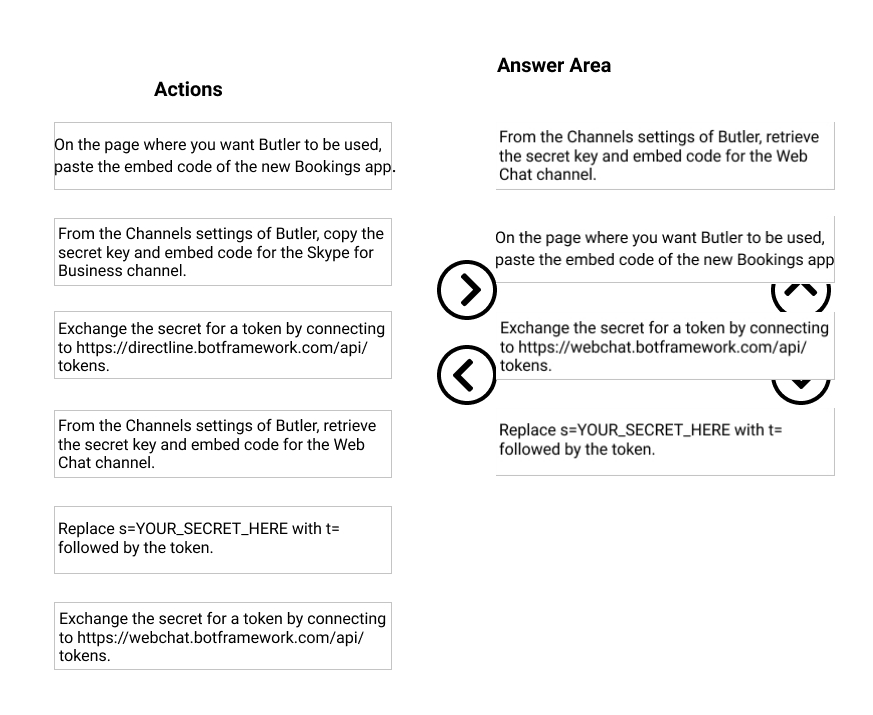AI-100 Mock Test Free – 50 Realistic Questions to Prepare with Confidence.
Getting ready for your AI-100 certification exam? Start your preparation the smart way with our AI-100 Mock Test Free – a carefully crafted set of 50 realistic, exam-style questions to help you practice effectively and boost your confidence.
Using a mock test free for AI-100 exam is one of the best ways to:
- Familiarize yourself with the actual exam format and question style
- Identify areas where you need more review
- Strengthen your time management and test-taking strategy
Below, you will find 50 free questions from our AI-100 Mock Test Free resource. These questions are structured to reflect the real exam’s difficulty and content areas, helping you assess your readiness accurately.
You have a Face API solution that updates in real time. A pilot of the solution runs successfully on a small dataset. When you attempt to use the solution on a larger dataset that continually changes, the performance degrades, slowing how long it takes to recognize existing faces. You need to recommend changes to reduce the time it takes to recognize existing faces without increasing costs. What should you recommend?
A. Change the solution to use the Computer Vision API instead of the Face API.
B. Separate training into an independent pipeline and schedule the pipeline to run daily.
C. Change the solution to use the Bing Image Search API instead of the Face API.
D. Distribute the face recognition inference process across many Azure Cognitive Services instances.
You need to create a new app that will consume resources from the following Azure Cognitive Services APIs: ✑ Face API ✑ Bing Search ✑ Text Analytics ✑ Translator Text ✑ Language Understanding (LUIS) The solution must prepare the development environment as quickly as possible. What should you create first from the Azure portal?
A. an Azure Key Vault resource
B. a Cognitive Services resource
C. an Azure Kubernetes Service (AKS) resource
D. Face and Language Understanding (LUIS) resources
HOTSPOT - You need to build a real-time media bot for Microsoft Skype on an Azure virtual machine. The bot will use the Azure Bot Service. The solution must minimize custom code. Which environment and language should you use to develop the bot? To answer, select the appropriate options in the answer area. NOTE: Each correct selection is worth one point. Hot Area:
DRAG DROP - You plan to use the Microsoft Bot Framework to develop bots that will be deployed by using the Azure Bot Service. You need to configure the Azure Bot Service to support the following types of bots: ✑ Bots that use Azure Functions ✑ Bots that set a timer-based Which template should you use for each bot type? To answer drag the appropriate templates to the correct bot type. Each template may be used once, more than once or not at all. You may need to drag the split bar between panes or scroll to view content. NOTE: Each correct selection is worth one point. Select and Place:
You are designing an AI workflow that will aggregate data stored in Azure as JSON documents. You expect to store more than 2 TB of new data daily. You need to choose the data storage service for the data. The solution must minimize costs. Which data storage service should you choose?
A. Azure Manage Disks
B. Azure Blob Storage
C. Azure File Storage
D. Azure Data Lake Storage
HOTSPOT - You plan to deploy an Azure Data Factory pipeline that will perform the following: ✑ Move data from on-premises to the cloud. ✑ Consume Azure Cognitive Services APIs. You need to recommend which technologies the pipeline should use. The solution must minimize custom code. What should you include in the recommendation? To answer, select the appropriate options in the answer area. NOTE: Each correct selection is worth one point. Hot Area:
After you answer a question, you will NOT be able to return to it. As a result, these questions will not appear in the review screen. You need to create an IoT solution that performs the following tasks: ✑ Identifies hazards ✑ Provides a real-time online dashboard ✑ Takes images of an area every minute ✑ Counts the number of people in an area every minute Solution: You configure the IoT devices to send the images to an Azure IoT hub, and then you configure an Azure Functions call to Azure Cognitive Services that sends the results to an Azure event hub. You configure Microsoft Power BI to connect to the event hub by using Azure Stream Analytics. Does this meet the goal?
A. Yes
B. No
Your company is about to deploy an Azure Machine Learning experiment. The company is concerned that the experiment might not be adhering to GDPR regulations. You have been instructed to do a review of the experiment's adherence to GDPR regulations. You must perform the review as quickly as possible. Which of the following actions should you take?
A. Make use of Azure Policy
B. Make use of Azure Security Center
C. Make use of Azure Log Analytics
D. Make use of Compliance Manager
You plan to design an application that will use data from Azure Data Lake and perform sentiment analysis by using Azure Machine Learning algorithms. The developers of the application use a mix of Windows- and Linux-based environments. The developers contribute to shared GitHub repositories. You need all the developers to use the same tool to develop the application. What is the best tool to use? More than one answer choice may achieve the goal.
A. Microsoft Visual Studio Code
B. Azure Notebooks
C. Azure Machine Learning Studio
D. Microsoft Visual Studio
DRAG DROP - You are developing an application for photo classification. Users of the application will include minors. The users will upload photos to the application. The photos will be stored for model training purposes. All the photos must be considered appropriate for minors. You need to recommend an architecture for the application. Which Azure services should you recommend using in the architecture? To answer, drag the appropriate services to the correct targets. Each service may be used once, more than once, or not at all. You may need to drag the split bar between panes or scroll to view content. NOTE: Each correct selection is worth one point. Select and Place:
You are designing an AI solution that will provide feedback to teachers who train students over the Internet. The students will be in classrooms located in remote areas. The solution will capture video and audio data of the students in the classrooms. You need to recommend Azure Cognitive Services for the AI solution to meet the following requirements: ✑ Alert teachers if a student facial expression indicates the student is angry or scared. ✑ Identify each student in the classrooms for attendance purposes. ✑ Allow the teachers to log voice conversations as text. Which Cognitive Services should you recommend?
A. Face API and Text Analytics
B. Computer Vision and Text Analytics
C. QnA Maker and Computer Vision
D. Speech to Text and Face API
Your company manages a sports team. The company sets up a video booth to record messages for the team. Before replaying the messages on a video screen, you need to generate captions for the messages and check the sentiment of the video to ensure that only positive messages are played. Which Azure Cognitive Services service should you use?
A. Language Understanding (LUIS)
B. Speaker Recognition
C. Custom Vision
D. Video Indexer
DRAG DROP - You need to build an AI solution that will be shared between several developers and customers. You plan to write code, host code, and document the runtime all within a single user experience. You build the environment to host the solution. Which three actions should you perform in sequence next? To answer, move the appropriate actions from the list of actions to the answer area and arrange them in the correct order. Select and Place:
After you answer a question, you will NOT be able to return to it. As a result, these questions will not appear in the review screen. You are deploying an Azure Machine Learning model to an Azure Kubernetes Service (AKS) container. You need to monitor the scoring accuracy of each run of the model. Solution: You modify the Config.json file. Does this meet the goal?
A. Yes
B. No
You are developing an app that will analyze sensitive data from global users. Your app must adhere the following compliance policies: The app must not store data in the cloud. The app not use services in the cloud to process the data. Which of the following actions should you take?
A. Make use of Azure Machine Learning Studio
B. Make use of Docker containers for the Text Analytics
C. Make use of a Text Analytics container deployed to Azure Kubernetes Service
D. Make use of Microsoft Machine Learning (MML) for Apache Spark
HOTSPOT - You plan to use Azure Cognitive Services to provide the development team at your company with the ability to create intelligent apps without having direct AI or data science skills. The company identifies the following requirements for the planned Cognitive Services deployment: ✑ Provide support for the following languages: English, Portuguese, and German. ✑ Perform text analytics to derive a sentiment score. Which Cognitive Service service should you deploy for each requirement? To answer, select the appropriate options in the answer area. NOTE: Each correct selection is worth one point. Hot Area:
You have Azure IoT Edge devices that collect measurements every 30 seconds. You plan to send the measurements to an Azure IoT hub. You need to process events in the cloud and account for missing data. What should you use?
A. Apache Kafka
B. Azure Stream Analytics record functions
C. Azure Stream Analytics windowing functions
D. Azure Machine Learning on the IoT Edge devices
DRAG DROP - You have an intelligent edge solution that processes data and outputs the data to an Azure Cosmos DB account that uses the SQL API. You need to ensure that you can perform full text searches of the data. Which three actions should you perform in sequence? To answer, move the appropriate actions from the list of actions to the answer area and arrange them in the correct order. Select and Place:
After you answer a question, you will NOT be able to return to it. As a result, these questions will not appear in the review screen. You are deploying an Azure Machine Learning model to an Azure Kubernetes Service (AKS) container. You need to monitor the scoring accuracy of each run of the model. Solution: You configure Azure Monitor for containers. Does this meet the goal?
A. Yes
B. No
Your company has factories in 10 countries. Each factory contains several thousand IoT devices. The devices present status and trending data on a dashboard. You need to ingest the data from the IoT devices into a data warehouse. Which two Microsoft Azure technologies should you use? Each correct answer presents part of the solution. NOTE: Each correct selection is worth one point.
A. Azure Stream Analytics
B. Azure Data Factory
C. an Azure HDInsight cluster
D. Azure Batch
E. Azure Data Lake
HOTSPOT - You are designing a solution that will analyze bank transactions in real time. The transactions will be evaluated by using an algorithm and classified into one of five groups. The transaction data will be enriched with information taken from Azure SQL Database before the transactions are sent to the classification process. The enrichment process will require custom code. Data from different banks will require different stored procedures. You need to develop a pipeline for the solution. Which components should you use for data ingestion and data preparation? To answer, select the appropriate options in the answer area. NOTE: Each correct selection is worth one point. Hot Area:
Your company is building custom models that integrate into microservices architecture on Azure Kubernetes Services (AKS). The model is built by using Python and published to AKS. You need to update the model and enable Azure Application Insights for the model. What should you use?
A. the Azure CLI
B. MLNET Model Builder
C. the Azure Machine Learning SDK
D. the Azure portal
After you answer a question, you will NOT be able to return to it. As a result, these questions will not appear in the review screen. You are deploying an Azure Machine Learning model to an Azure Kubernetes Service (AKS) container. You need to monitor the scoring accuracy of each run of the model. Solution: You modify the scoring file. Does this meet the goal?
A. Yes
B. No
Your company's marketing department is creating a social media campaign that will allow users to submit video messages for the company's social media sites. You are developing an AI app for the campaign. Your app must meet the following requirements: Add captions to the video messages before they are posted to the social media sites. Ensure that no negative video messages are posted to the social media sites. Which of the following actions should you take?
A. Implement Form Recognizer in your app.
B. Implement the Face API in your app.
C. Implement Custom Vision in your app.
D. Implement Video Indexer in your app.
After you answer a question, you will NOT be able to return to it. As a result, these questions will not appear in the review screen. You have an Azure SQL database, an Azure Data Lake Storage Gen 2 account, and an API developed by using Azure Machine Learning Studio. You need to ingest data once daily from the database, score each row by using the API, and write the data to the storage account. Solution: You create an Azure Data Factory pipeline that contains a Machine Learning Execute Pipeline activity. Does this meet the goal?
A. Yes
B. No
You build an internal application that uses the Computer Vision API. You need to ensure that only specific employees can access the application. What should you include in the solution?
A. a single-service subscription key
B. user principals in Azure Active Directory (Azure AD)
C. service principals in Azure Active Directory (Azure AD)
D. a multi-service subscription key
You plan to implement a new data warehouse for a planned AI solution. You have the following information regarding the data warehouse: ✑ The data files will be available in one week. ✑ Most queries that will be executed against the data warehouse will be ad-hoc queries. ✑ The schemas of data files that will be loaded to the data warehouse will change often. ✑ One month after the planned implementation, the data warehouse will contain 15 TB of data. You need to recommend a database solution to support the planned implementation. What two solutions should you include in the recommendation? Each correct answer is a complete solution. NOTE: Each correct selection is worth one point.
A. Apache Hadoop
B. Apache Spark
C. A Microsoft Azure SQL database
D. An Azure virtual machine that runs Microsoft SQL Server
You need to build an API pipeline that analyzes streaming data. The pipeline will perform the following: ✑ Visual text recognition ✑ Audio transcription ✑ Sentiment analysis ✑ Face detection Which Azure Cognitive Services should you use in the pipeline?
A. Custom Speech Service
B. Face API
C. Text Analytics
D. Video Indexer
You are developing an app for a conference provider. The app will use speech-to-text to provide transcription at a conference in English. It will also use the Translator Text API to translate the transcripts to the language preferred by the conference attendees. You test the translation features on the app and discover that the translations are fairly poor. You want to improve the quality of the translations. Which of the following actions should you take?
A. Use Text Analytics to perform the translations.
B. Use the Language Understanding (LUIS) API to perform the translations.
C. Perform the translations by training a custom model using Custom Translator.
D. Use the Computer Vision API to perform the translations.
You have an SAP production landscape. You plan to use Azure Machine Learning to develop a fraud detection API. The API will identify potentially fraudulent transactions in the SAP production landscape in near real time. You need to recommend a workflow for the API. What should you recommend?
A. an Azure Data Factory pipeline that uses an SAP table connector and a Machine Learning Execute Pipeline activity
B. a Microsoft Excel workbook that imports SAP transactions and uses the Excel add-in for web services to score the transactions
C. an Azure logic app triggered by an SAP message that calls the API and sends an email based on the results
D. a scheduled Jupyter Notebook in Azure Databricks that connects to SAP HANA
Your company has recently deployed 5,000 Internet-connected sensors for a planned AI solution. You need to recommend a computing solution to perform a real-time analysis of the data generated by the sensors. Which computing solution should you recommend?
A. an Azure HDInsight Storm cluster
B. Azure Notification Hubs
C. an Azure HDInsight Hadoop cluster
D. an Azure HDInsight R cluster
You have Azure IoT Edge devices that generate measurement data from temperature sensors. The data changes very slowly. You need to analyze the data in a temporal two-minute window. If the temperature rises five degrees above a limit, an alert must be raised. The solution must minimize the development of custom code. What should you use?
A. A Machine Learning model as a web service
B. an Azure Machine Learning model as an IoT Edge module
C. Azure Stream Analytics as an IoT Edge module
D. Azure Functions as an IoT Edge module
You are developing a mobile application that will perform optical character recognition (OCR) from photos. The application will annotate the photos by using metadata, store the photos in Azure Blob storage, and then score the photos by using an Azure Machine Learning model. What should you use to process the data?
A. Azure Event Hubs
B. Azure Functions
C. Azure Stream Analytics
D. Azure Batch
After you answer a question, you will NOT be able to return to it. As a result, these questions will not appear in the review screen. You have Azure IoT Edge devices that generate streaming data. On the devices, you need to detect anomalies in the data by using Azure Machine Learning models. Once an anomaly is detected, the devices must add information about the anomaly to the Azure IoT Hub stream. Solution: You deploy Azure Functions as an IoT Edge module. Does this meet the goal?
A. Yes
B. No
Your company has several AI solutions and bots. You need to implement a solution to monitor the utilization of the bots. The solution must ensure that analysts at the company can generate dashboards to review the utilization. What should you include in the solution?
A. Azure Application Insights
B. Azure Data Explorer
C. Azure Logic Apps
D. Azure Monitor
DRAG DROP - You need to build a pipeline for an Azure Machine Learning experiment. In which order should you perform the actions? To answer, move all actions from the list of actions to the answer area and arrange them in the correct order. Select and Place:
Your company creates a popular mobile game. The company tracks usage patterns of the game. You need to provide special offers to users when there is a significant change in the usage patterns. Which Azure Cognitive Services service should you use?
A. Form Recognizer
B. Bing Autosuggest
C. Text Analytics
D. Anomaly Detector
After you answer a question, you will NOT be able to return to it. As a result, these questions will not appear in the review screen. You have an app named App1 that uses the Face API. App1 contains several PersonGroup objects. You discover that a PersonGroup object for an individual named Ben Smith cannot accept additional entries. The PersonGroup object for Ben Smith contains 10,000 entries. You need to ensure that additional entries can be added to the PersonGroup object for Ben Smith. The solution must ensure that Ben Smith can be identified by all the entries. Solution: You migrate all the entries to the LargePersonGroup object for Ben Smith. Does this meet the goal?
A. Yes
B. No
A data scientist deploys a deep learning model on an Fsv2 virtual machine. Data analysis is slow. You need to recommend which virtual machine series the data scientist must use to ensure that data analysis occurs as quickly as possible. Which series should you recommend?
A. ND
B. B
C. DC
D. Ev3
You are designing a real-time speech-to-text AI feature for an Android mobile app. The feature will stream data to the Speech service. You need to recommend which audio format to use to serialize the audio. The solution must minimize the amount of data transferred to the cloud. What should you recommend?
A. MP3
B. WAV/PCM
C. MP4a
After you answer a question, you will NOT be able to return to it. As a result, these questions will not appear in the review screen. You have an Azure SQL database, an Azure Data Lake Storage Gen 2 account, and an API developed by using Azure Machine Learning Studio. You need to ingest data once daily from the database, score each row by using the API, and write the data to the storage account. Solution: You create an Azure Data Factory pipeline that contains a Jupyter Notebook activity. Does this meet the goal?
A. Yes
B. No
You plan to deploy Azure IoT Edge devices. Each device will store more than 10,000 images locally. Each image is approximately 5 MB. You need to ensure that the images persist on the devices for 14 days. What should you use?
A. Azure Stream Analytics on the IoT Edge devices
B. Azure Database for Postgres SQL
C. Azure Blob storage on the IoT Edge devices
D. Microsoft SQL Server on the IoT Edge devices
You have deployed several Azure IoT Edge devices for an AI solution. The Azure IoT Edge devices generate measurement data from temperature sensors. You need a solution to process the sensor data. Your solution must be able to write configuration changes back to the devices. You make use of Microsoft Azure IoT Hub. Does this action accomplish your objective?
A. Yes, it does
B. No, it does not
You have an app that records meetings by using speech-to-text capabilities from the Speech Services API. You discover that when action items are listed at the end of each meeting, the app transcribes the text inaccurately when industry terms are used. You need to improve the accuracy of the meeting records. What should you do?
A. Add a phrase list
B. Create a custom wake word
C. Parse the text by using the Language Understanding (LUIS) API
D. Train a custom model by using Custom Translator
You are designing the infrastructure for an AI solution that will analyze data stored in Azure Blob storage. You want to encrypt the storage account by using a key generated by the hardware security module (HSM) of your company. What should you do first?
A. Enable encryption with customer-managed keys.
B. Generate an access key.
C. Generate an encryption key.
D. Configure a service endpoint for the storage account.
DRAG DROP - You need to integrate the new Bookings app and the Butler chabot. Which four actions should you perform in sequence? To answer, move the appropriate actions from the list of actions to the answer area and arrange them in the correct order. Select and Place:
Your company plans to create a mobile app that will be used by employees to query the employee handbook. You need to ensure that the employees can query the handbook by typing or by using speech. Which core component should you use for the app?
A. Language Understanding (LUIS)
B. QnA Maker
C. Text Analytics
D. Azure Search
After you answer a question, you will NOT be able to return to it. As a result, these questions will not appear in the review screen. You have an app named App1 that uses the Face API. App1 contains several PersonGroup objects. You discover that a PersonGroup object for an individual named Ben Smith cannot accept additional entries. The PersonGroup object for Ben Smith contains 10,000 entries. You need to ensure that additional entries can be added to the PersonGroup object for Ben Smith. The solution must ensure that Ben Smith can be identified by all the entries. Solution: You modify the custom time interval for the training phase of App1. Does this meet the goal?
A. Yes
B. No
You are developing a Microsoft Bot Framework application. The application consumes structured NoSQL data that must be stored in the cloud. You implement Azure Blob storage for the application. You want access to the blob store to be controlled by using a role. You implement Shared Access Signatures (SAS) on the storage account. Does this action accomplish your objective?
A. Yes, it does
B. No, it does not
You are developing a mobile app for a conference provider. The mobile app will use speech-to-text to provide real-time transcription at a conference. You need to ensure that the app can identify participants at the conference when they make contributions. What actions should you take?
A. Instruct each participant to record the conference in the .wav format.
B. Instruct each participant to create a voice signature.
C. Instruct each participant to sign up for Azure Speech Services.
D. Instruct each participant to install the Speech SDK on their mobile device.
Access Full AI-100 Mock Test Free
Want a full-length mock test experience? Click here to unlock the complete AI-100 Mock Test Free set and get access to hundreds of additional practice questions covering all key topics.
We regularly update our question sets to stay aligned with the latest exam objectives—so check back often for fresh content!
Start practicing with our AI-100 mock test free today—and take a major step toward exam success!


